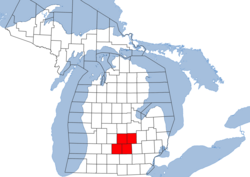Lansing–East Lansing metropolitan area
Metropolitan Area in Michigan, United States From Wikipedia, the free encyclopedia
Metropolitan Area in Michigan, United States From Wikipedia, the free encyclopedia
Metro Lansing
Lansing–East Lansing MSA | |
|---|---|
 Aerial image of Lansing | |
 Location of the Lansing–East Lansing MSA | |
| Country | United States |
| State | Michigan |
| Largest city | Lansing |
| Counties | |
| Area | |
| • Urban | 158.1 sq mi (409 km2) |
| • MSA | 1,714.7 sq mi (4,441 km2) |
| Highest elevation | 1,050 ft (320 m) |
| Lowest elevation | 830 ft (250 m) |
| Population | |
| • Urban | 313,532 |
| • MSA | 473,203 |
| GDP | |
| • MSA | $32.633 billion (2022) |
| Time zone | UTC-5 (EST) |
| • Summer (DST) | UTC-4 (EDT) |
| Area code(s) | 517, 989 |
The Lansing–East Lansing Metropolitan Statistical Area is a metropolitan area located in Central Michigan defined by the Office of Management and Budget, and encompassing the counties of Eaton, Clinton, and Ingham. The region is colloquially referred to as "Mid" or Central Michigan, and less often as "Greater Lansing" or the "Capital Area". As of the 2020 census, the MSA had a population of 473,203. It ranks as Michigan's third-largest metropolitan area behind metropolitan Detroit and Grand Rapids.
The metropolitan area was originally defined as only including Ingham County in 1950, but Eaton and Clinton counties were added in 1960. Ionia County was added in 1973, but taken out a decade later for the 1990 Census.[4] Shiawassee County was added in 2018 after commuting flows increased enough for it to qualify as an "outlying county"[5] but was removed when core-based statistical areas (CBSAs) were re-delineated in 2023.[6] It forms a combined statistical area (CSA) with Metro Lansing designated the Lansing-East Lansing-Owosso, MI CSA.
The Lansing Urban Area, as defined by the U.S. Census Bureau, which measures the extent of the built-up area, had a population of 313,532 as of the 2010 census.
Lansing–East Lansing MSA

As of the census[8] of 2020, there were 541,297 people residing within the MSA. The racial makeup of the MSA was 77.6% White, 8.3% African American, 0.4% Native American, 3.9% Asian, 0.00% Pacific Islander, 2.2% from other races, and 7.3% from two or more races. Hispanic or Latino of any race were 6.8% of the population.
As of the census[9] of 2010, there were 464,036 people, 183,442 households, and 112,131 families residing within the MSA. The racial makeup of the MSA was 81.6% White, 8.9% African American, 0.5% Native American, 3.8% Asian, 0.03% Pacific Islander, 1.9% from other races, and 3.3% from two or more races. Hispanic or Latino of any race were 3.9% of the population.
As of the 2010 American Community Survey estimates, the median income for a household in the MSA was $47,731, and the median income for a family was $60,602. The per capita income for the MSA was $23,359. The region's foreign-born population sat at 7.0%.
Seamless Wikipedia browsing. On steroids.
Every time you click a link to Wikipedia, Wiktionary or Wikiquote in your browser's search results, it will show the modern Wikiwand interface.
Wikiwand extension is a five stars, simple, with minimum permission required to keep your browsing private, safe and transparent.